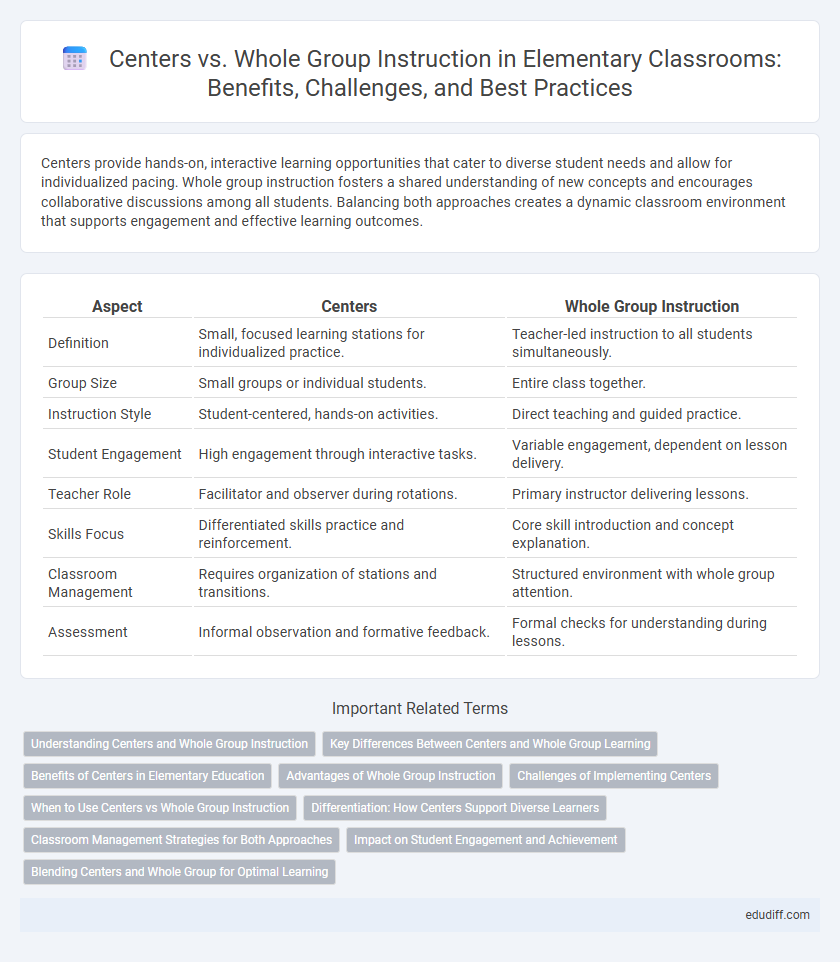Centers provide hands-on, interactive learning opportunities that cater to diverse student needs and allow for individualized pacing. Whole group instruction fosters a shared understanding of new concepts and encourages collaborative discussions among all students. Balancing both approaches creates a dynamic classroom environment that supports engagement and effective learning outcomes.
Table of Comparison
| Aspect | Centers | Whole Group Instruction |
|---|---|---|
| Definition | Small, focused learning stations for individualized practice. | Teacher-led instruction to all students simultaneously. |
| Group Size | Small groups or individual students. | Entire class together. |
| Instruction Style | Student-centered, hands-on activities. | Direct teaching and guided practice. |
| Student Engagement | High engagement through interactive tasks. | Variable engagement, dependent on lesson delivery. |
| Teacher Role | Facilitator and observer during rotations. | Primary instructor delivering lessons. |
| Skills Focus | Differentiated skills practice and reinforcement. | Core skill introduction and concept explanation. |
| Classroom Management | Requires organization of stations and transitions. | Structured environment with whole group attention. |
| Assessment | Informal observation and formative feedback. | Formal checks for understanding during lessons. |
Understanding Centers and Whole Group Instruction
Centers encourage active learning through small group activities tailored to diverse student needs, promoting collaboration and hands-on experiences. Whole group instruction provides a unified learning approach where the teacher directs focus on core concepts and skills, ensuring consistent understanding for all students. Balancing centers and whole group instruction optimizes engagement and achievement in the elementary classroom.
Key Differences Between Centers and Whole Group Learning
Centers in elementary classrooms offer small-group, hands-on learning activities tailored to students' needs and promote collaboration and independent problem-solving. Whole group instruction involves teacher-led lessons with the entire class focusing on collective learning objectives and maintaining uniform pacing. Key differences include student engagement dynamics, instructional flexibility, and the opportunity for differentiated learning experiences in centers compared to the structured, teacher-directed approach of whole group instruction.
Benefits of Centers in Elementary Education
Centers in elementary education promote active learning by engaging students in hands-on activities tailored to diverse learning styles, improving retention and understanding. They encourage collaboration and social skills development as students work in small groups, fostering peer interaction and communication. Centers also allow for differentiated instruction, enabling teachers to provide targeted support and challenge based on individual student needs.
Advantages of Whole Group Instruction
Whole group instruction in elementary classrooms promotes consistent delivery of core content, ensuring all students receive the same foundational lessons simultaneously. This method enhances classroom management by fostering a unified learning environment where teacher directions and expectations are clear. It also encourages peer interaction and collective participation, boosting social skills and collaborative learning among young students.
Challenges of Implementing Centers
Implementing centers in elementary classrooms presents challenges such as managing diverse student behaviors and ensuring consistent engagement across all groups. Teachers must effectively plan varied activities that accommodate different learning styles while maintaining classroom order. Limited resources and time constraints can further complicate smooth rotation and individualized support during center activities.
When to Use Centers vs Whole Group Instruction
Centers are ideal for hands-on activities, allowing elementary students to work independently or in small groups to reinforce skills at their own pace. Whole group instruction is best for introducing new concepts, ensuring that all students receive the same foundational information simultaneously. Use centers for differentiated learning and review, while whole group instruction facilitates direct teacher guidance and classroom discussion.
Differentiation: How Centers Support Diverse Learners
Centers promote differentiation by allowing teachers to tailor activities to varied learning styles and ability levels, providing targeted support within small groups. Students benefit from hands-on tasks and individualized attention, which enhances engagement and mastery of concepts. This flexible approach fosters inclusive learning environments that meet diverse academic needs more effectively than whole group instruction.
Classroom Management Strategies for Both Approaches
Effective classroom management strategies vary between centers and whole group instruction in elementary settings. Centers require clear guidelines, station rotations, and student accountability to maintain engagement and minimize distractions, while whole group instruction benefits from structured routines, direct teacher control, and consistent behavior expectations to foster a focused learning environment. Implementing visual schedules and positive reinforcement supports smooth transitions and sustained student attention across both instructional approaches.
Impact on Student Engagement and Achievement
Centers in elementary classrooms boost student engagement by allowing hands-on, interactive activities tailored to various learning styles, which leads to improved achievement through personalized practice. Whole Group Instruction provides a unified learning experience, ensuring that all students receive the same foundational content, but may limit individual participation and slow engagement for diverse learners. Research shows that combining centers with whole group teaching maximizes student achievement by balancing structure with active, differentiated learning opportunities.
Blending Centers and Whole Group for Optimal Learning
Blending Centers and Whole Group Instruction in elementary classrooms maximizes student engagement and differentiated learning. Centers allow hands-on, personalized practice of skills like phonics and math facts, while Whole Group sessions deliver direct teaching and modeling of new concepts. Combining these approaches supports diverse learning styles and reinforces mastery through varied instructional formats.
Centers vs Whole Group Instruction Infographic

 edudiff.com
edudiff.com